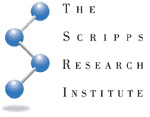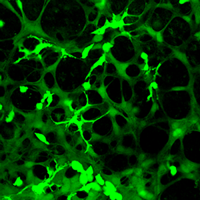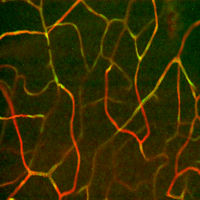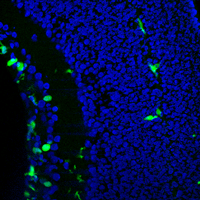Endothelial Progenitor
Cell Biology
| Home |
| Research |
| Personnel |
| Publications |
| Funding Acknowledgments |
|
We have demonstrated that Lin- bone marrow cells and astrocytes specifically interact with one another during normal and pathological angiogenesis in the eye and suggest that this selective targeting may be a useful therapeutic approach for the treatment of many ocular diseases including diabetic retinopathy, age related macular degeneration and certain inherited retinal degenerations. (Otani et. al., 2002). Adult bone marrow contains a population of cells capable of differentiating along hematopoietic (Lin+) or non-hematopoietic (Lin-) lineages. Lin- hematopoietic stem cells have recently been shown to contain endothelial precursors capable of forming blood vessels. We have found that intravitreally injected Lin- bone marrow cells selectively target to retinal astrocytes, a cell that serves as a template for both developmental and injury-associated retinal angiogenesis. When these cells are injected into neonatal mouse eyes, they extensively and stably incorporate into forming retinal vasculature. If endothelial precursor cell-enriched hematopoietic stem cells were injected into eyes of neonatal mice with retinal degeneration whose vasculature ordinarily degenerates with age, they rescued and maintained a normal vasculature. In contrast, retinal angiogenesis in normal neonatal mice was inhibited when endothelial precursor cells transfected prior to intraocular administration expressed a potent angiostatic protein. We are currently characterizing the biochemical basis for the HSC-glial interaction and hope to develop this model further for the cell-based treatment of ocular neovascularization.
Relevant Publications: Ritter, M., Banin, E., Aguilar, E.A., Dorrell, M.I. Moreno S.K. and M. Friedlander (2006). Myeloid progenitors differentiate into microglia and promote vascular repair in a model of ischemic retinopathy. J. Clin. Invest. 116:3266-3276. Jin, H., Aiyer, A., Su, J., Borgstrom, P., Stupack, D., Friedlander, M. And Varner, J. (2006). A homing mechanism for bone marrow derived progenitor cell recruitment to the neovasculature. J. Clin. Invest., 116(3):652-62. Otani, A., Kinder, K., Hanekamp, S., Nussinowitz,S., Heckenlively, J., and Friedlander, M. (2004). Neurotrophic rescue of retinal degeneration by intravitreally injected adult bone marrow derived lineage- hematopoietic stem cells. J. Clinical Investigation, 114:765-774. Dorrell, M.I., Otani, A., Aguilar, E.A., Moreno, S. and Friedlander, M. (2004). Adult bone marrow-derived stem cells utilize R-cadherin to target sites of neovascularization in the developing retina. Blood 103: 3420-3427. Otani, A., Kinder, K., Ewalt, K., Otero, F., Schimmel, P. and Friedlander, M. (2002). Bone marrow derived stem cells cells target retinal astrocytes and have pro- or anti-angiogenic activity. Nature Medicine: 8:1004-1010. |
|
| © 2009 The Scripps Research Institute - All Rights Reserved |



